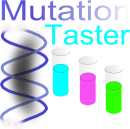
 |
Mutation T@sterTutorial |
Imagine a patient suffering from ALS. You decide to sequence the exons of the SOD1 gene. By looking at the sequence reads, you find an A->G point mutation. The sequence after this exchange is TGTTCATGAGTTTGGAGATAATACAGCAGGCTGT.
Open the web interface, enter the gene symbol (SOD1) and select the correct transcript (ENST00000270142). Then select the radio button for coding sequence positions and enter the snippet in the dbSNP format (i.e. [A/G]TGTTCATGAGTTTGGAGATAATACAGCAGGCTGT) into the snippet field. Now click on submit...
This point mutation mutation is known to cause ALS (AMYOTROPHIC LATERAL SCLEROSIS 1, OMIM 147450#0008). The involved amino acid residue is highly conserved and is responsible for the copper-binding activity (displayed as lost protein feature). Also, the phyloP and phastCons values are very high, indicating strong evolutionary conservation.Imagine a patient with a muscular disease. Among others, you sequence the complete sequence of the agrin (AGRN) gene and find a deletion of 2 bases: AG at position 28670 and 28671. Is this likely to be disease-causing, e.g. by destroying the reading frame? Now imagine that you are too lazy (or too clever) to look up all exons by hand...
Open the web interface, enter the gene symbol (AGRN) and select a transcript (e.g. ENST00000379370). Then select the radio button for gene positions and enter the last reference base upstream of the alteration (28669), the first reference base downstream the alteration(28672), and the inserted bases (nothing). You will see the gene sequence below the input fields, helping you to check if you 'delete' the correct bases. Now click on submit...
This example alteration is a deletion which was also found in the 1000Genomes Project (TGP) in homozygous state. There is no amino acid change. The altered base is hardly conserved, as conveyed by the low phyloP / phastCons values.Imagine you sequenced the complete exome of a patient suffering from Myasthenic syndrome. You find a mutation in the gene for the delta subunit of the nicotinic acetylchloline receptor on chromosome 2 (chr2:233391374t>c). Imagine that you are too lazy to determine gene-specific positions.
Open the web interface for physical positions, enter the chromosome (2), the physical position (233391374) and reference allele (t) and variant (c). Now click on submit...
Imagine you sequenced a complete genome of a patient with Myasthenic syndrome. Amanzingly, you end up with just 5 alterations
Go to our 'QueryEngine', download the sample file and upload it to the QueryEngine. Feel free to play around with the TGP filters!
On the results page, click on 'display' to get a closer look at the results. Click on GeneDistiller links on the right side to check the likelihood of the genes involved to be disease causing.
Please don't imagine that I was lazy - but the analysis of a complete genome needs hours to complete. An exome is completed within 30 minutes, but having many simultaneous analyses would put a high load onto our server...